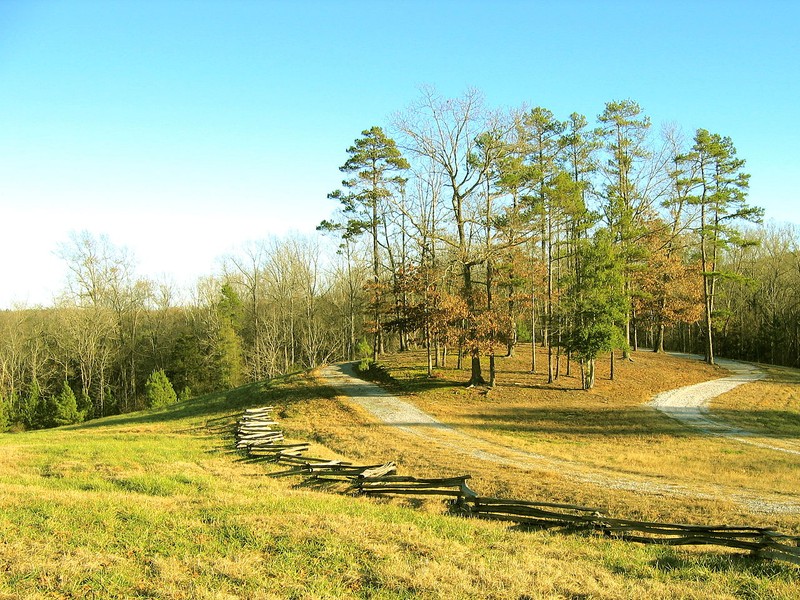Battle of Blackstock's Farm Historical Marker
Introduction
Text-to-speech Audio
Dedicated in 1986 by the local chapter of the Sons of the American Revolution, this marker commemorates the Battle of Blackstock's Farm, a small battle during the American Revolutionary War that occurred here on November 20, 1780. On that day, Patriot militiamen led by General Thomas Sumter won a decisive victory over a British force commanded by Lt. Colonel Banaste Tarleton. This confrontation came to be known as the Battle of Blackstock's Farm as it occurred on a plantation owned by a planter named William Blackstock. The site, which is a hilly area located just south of the Tyger River, consists of a looped road, a historical stone marker, and open field. No physical remains of the battle or the log buildings of the plantation still exist. The plantation house (or barn) was located in the vicinity of where the marker is now. Trees and vegetation now cover much of the plantation land.
Images
The Battle of Blackstock's Farm took place on November 20, 2021.

The battle occurred on William Blackstock's plantation, which is a few miles north of this marker.

Backstory and Context
Text-to-speech Audio
The Battle of Blackstock's Farm occurred in the midst of Southern theater of the war. In 1778, the British turned their attention to the south with the goal of gaining the upper hand in the war. Up until then, the largest battles had occurred in the northern colonies. The British made the decision based on the belief that there was a significant Loyalist support in the southern colonies, including in South Carolina. While there were Loyalists in these colonies (and many fought alongside British troops), it was less than expected.
The Battle of Blackstock's Farm took place just over a month after another Patriot victory at the decisive Battle of King's Mountain (October 7), which was fought between Patriot and Loyalist militias. After the defeat, the British commander of the southern theater, Lt. General Charles Cornwallis, ordered Tarleton to pursue and surprise Sumter, who was moving his troops toward a British military post called Ninety-Six. A British deserter, however, informed Sumter about Tarleton's approach and, on the November 20, Sumter ordered his troops to move to Blackstock's plantation where they took up defensive positions.
Sumter commanded roughly 1,000 militiamen and Tarleton led a force of around 500 men, which included British regulars and mounted cavalry. Sumter ordered some of his men to occupy the plantation buildings as well as behind fences and in the woods. Tarleton, worried that Sumter would escape across the river, decided to attack Sumter with his mounted infantry and cavalry before his troops and artillery arrived. However, during the battle which lasted several hours, the British suffered heavy losses as the Patriots were well positioned. Ultimately, Tarleton retreated and Sumter and his men crossed the river. Sumter was wounded (he recovered) and Tarleton claimed he forced Sumter to disperse his men. As a result Tarleton, wrongly, claimed victory. Only a few Patriots were killed or wounded (dozens were captured as well) while it is estimated that around 50-100 British men died. This defeat was Tarleton's first.
Sources
"The Battle of Blackstock's Plantation." RevolutionaryWar.us. Accessed June 22, 2021. https://revolutionarywar.us/year-1780/battle-Blackstocks-plantation.
"Blackstock's Plantation, Blackstock's Farm." American Battlefield Trust. Accessed June 22, 2021. https://www.battlefields.org/learn/revolutionary-war/battles/Blackstocks-plantation.
Califf III, John W. "Battle of Blackstock's Historic Site." National Park Service - National Register of Historic Places Nomination Form. November 20, 1780. https://npgallery.nps.gov/GetAsset/12a0bc5d-1987-48e9-a8d6-743af5055a1f.
Wikimedia Commons: https://commons.wikimedia.org/wiki/File:Blackstock.jpg
http://photos.historical-markers.org/South-Carolina/Union-County/SC-44-7-Battle-of-Blackstocks
